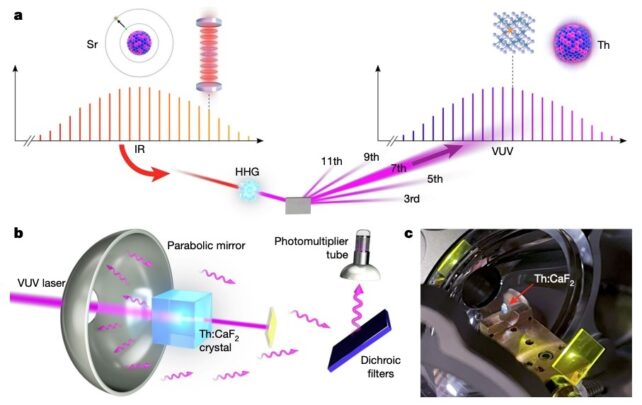Scientists created the prototype of the arena’s first atomic clock: ScienceAlert
A big leap forward constructed on many years of exhausting paintings has been accomplished only some months in the past, and scientists are realising its doable: measurements of the period between quantum power states of thorium nuclei were used to create the primary rudimentary atomic clock.
Through coupling a strontium atomic clock with a crystal containing thorium nuclei, a workforce of physicists has effectively demonstrated the core generation that may lead us to the primary fully-fledged atomic clock.
That milestone — which has but to be reached — will open up a brand new realm of ultra-precise scheduling.
“With this primary prototype, we’ve confirmed that thorium can be utilized as a timekeeper for ultra-high precision measurements,” explains Thorsten Sturm, a physicist on the Vienna College of Era.
“Handiest technical construction paintings stays now, and no main hurdles are anticipated.”
An atomic clock is person who depends on the extraordinarily exact ‘ticking’ of atoms as they transfer between power states when all for a laser, which might be decided through the states of the electrons orbiting across the nucleus on the centre of the atom.
On the other hand, that is a lot more tough to do with the nucleus, as a result of converting its power state takes a lot more power than converting the power state of the electrons.
On the other hand, an atomic clock is extremely fascinating, as it might be a lot more strong and correct than an atomic clock. In flip, an atomic clock would allow extra correct measurements of the bodily universe – which has implications for the whole lot from navigation to the seek for darkish subject.
The size of the power bounce – the adaptation between power states – of the thorium nucleus used to be introduced previous this 12 months. And it has helped Strum and his colleagues decide the precise power had to make the transition between power states, the mechanism in which an atomic clock would tick.
The next move used to be to exhibit that they may make a clock from this ticking, and that is what Sturm and his colleagues have now executed.
The clock they demonstrated isn’t a complete atomic clock enjoy, however a primary step in that course. The strontium clock at JILA of the Nationwide Institute of Requirements and Era is operated the usage of infrared mild.
The workforce created a tiny calcium fluoride crystal containing a thorium nucleus, whose power state is modified the usage of vacuum ultraviolet mild.

To attach the crystal to the atomic clock, the researchers had to be able to transform infrared mild into ultraviolet. They did this through making a frequency comb of infrared wavelengths and operating it thru xenon fuel, which interacts with infrared mild to emit ultraviolet wavelengths.
The end result used to be a blended frequency comb that might excite the transition of thorium nuclei and synchronize it with the ticking of strontium atoms.
The ensuing nuclear ticking is not more correct than a strontium atomic clock, however now that the fundamental idea has been demonstrated, the real generation is at the horizon — and really as regards to complete implementation, the researchers say.
“Believe a wristwatch that runs for billions of years and not loses a 2d,” says JILA physicist Jun Ye. “Even if we’ve not reached that stage but, this analysis brings us nearer to that stage of accuracy.”
The workforce carried out their experiment a number of instances; every time they got effects in keeping with the atomic clock. The next move might be to refine it.
“Once we first excited the transition, we had been in a position to decide the frequency to inside a couple of gigahertz. This used to be already 1000 instances higher than anything else recognized earlier than. On the other hand, we have accuracy within the kilohertz vary – which is one million instances higher once more,” says Schumm.
“On this means, we are hoping to overhaul the most productive atomic clocks in 2-3 years.”
This analysis used to be printed in 2014. Nature,
Supply hyperlink
#Scientists #created #prototype #worlds #atomic #clock #ScienceAlert


/https%3A%2F%2Ftf-cmsv2-smithsonianmag-media.s3.amazonaws.com%2Ffiler_public%2F18%2Fb6%2F18b6d2a8-c3ad-4d9a-bcc2-2f933f6f7298%2Fimage2_lokiceratops-scene_fabrizio-lavezzi_web.jpg)
